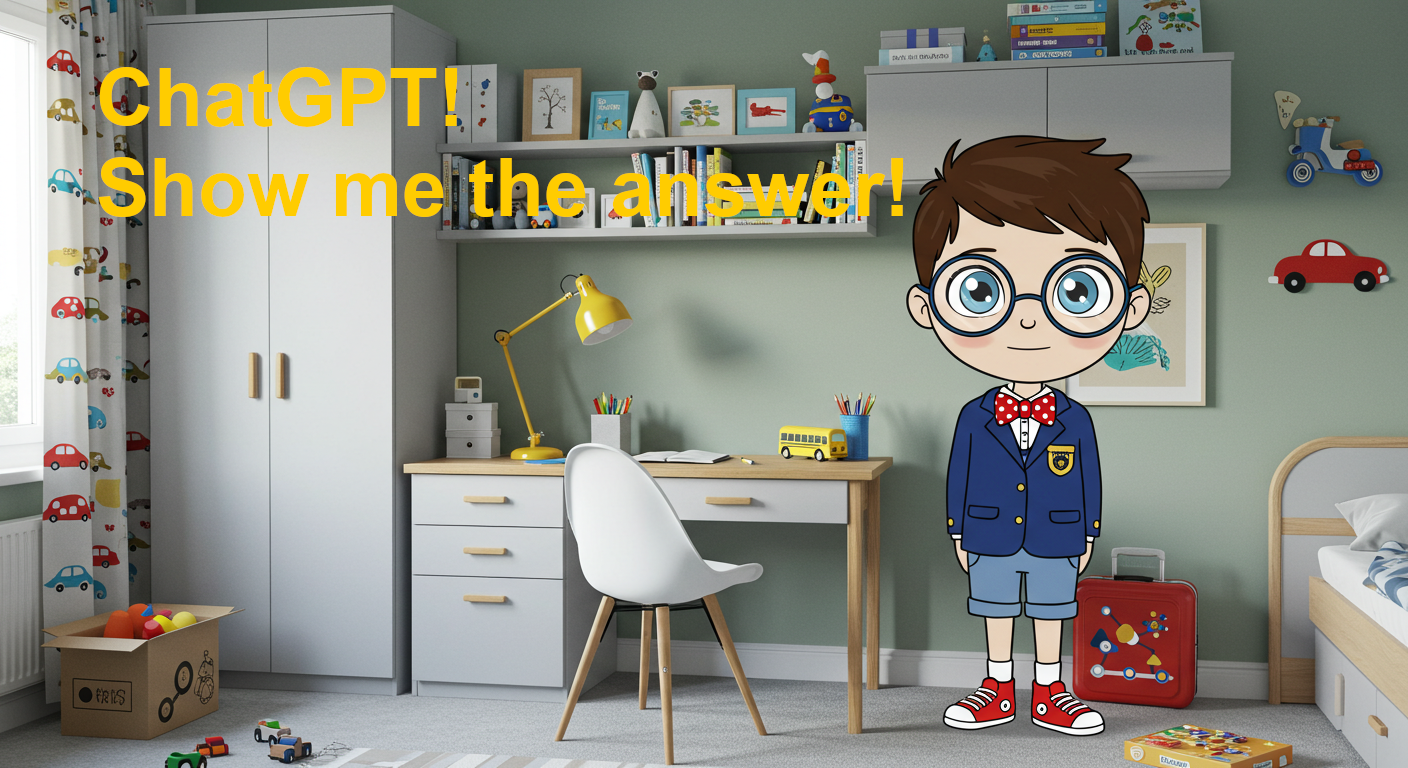
Posts in Schoolwork and the era of AI
- The Rise of Praise Inflation: when “Good job” is not enough
- Why Is Schoolwork Getting Easier? A Global Quest for A’s
If your kid’s glued to a screen or asking AI to do their homework faster than you can say “bedtime,” you’re not alone.
Welcome to the era of AI and screens, where TikTok dances and instant answers rule the day.
But don’t worry—our kids can thrive in this digital jungle without falling into the instant gratification trap. I’m here to share five practical tips, packed with real-world examples, to help our kids shine as tech-savvy, focused learners. Let’s turn screens into springboards for success!
1. Make AI a Mentor, Not a Magician
AI tools like math solvers or essay generators can be tempting shortcuts, but they’re goldmines when used for learning, not cheating. Guide your kids to use AI as a teacher, not a homework-dodging wizard.

Example:
If your kid’s struggling with fractions, download a kid-friendly app and have them play its puzzle games to learn concepts visually. Then, ask an AI tool like Khan Academy’s tutor to explain a tricky problem step-by-step, rather than just giving the answer.
Set a rule: “Use AI to understand, not to finish.”
Parent Action:
Sit with your child for 10 minutes weekly to explore a learning app together. For instance, try Code.org’s AI for Oceans project, where kids train AI to sort ocean trash—fun and educational!
Why It Works:
Using AI for feedback, not solutions, boosts problem-solving. A 2023 Stanford study found kids who used AI for explanations improved math skills by 15% over those who copied answers.
2. Build Grit with Delayed Gratification Games
Screens train kids to crave instant rewards (hello, Instagram likes!). Teach them to wait for bigger wins to build focus and resilience.

Example:
Create a “Homework Hero” chart. For every 30 minutes of focused study without checking their phone, your kid earns a star. After 10 stars, they get a reward, like a movie night or extra game time.
Or, use an app like Habitica, which turns tasks into a role-playing game where kids “level up” by completing goals.
Parent Action:
Model delayed gratification. Say, “I’m saving my screen time to watch my favorite show after dinner—want to join me?” Try a family “no-phone” study hour, followed by a fun board game like Uno as a reward.
Why It Works:
Practicing delayed gratification strengthens self-control. A 2021 University of Rochester study showed kids trained this way scored 10–20% higher on attention-based tests.
3. Swap Screens for Hands-On Adventures
With U.S. teens averaging 2.5 hours of daily screen time (2024 Common Sense Media), hands-on activities are key to sparking curiosity and countering passive tech use.
Example:
Set up a “Science Saturday” where kids build a baking soda volcano or a paper airplane launcher to test aerodynamics. No screens allowed!
For older kids, try a DIY coding project with a Raspberry Pi (under $50) to build a mini-game, blending tech and creativity.

Parent Action:
Dedicate one weekend afternoon to an unplugged activity. Visit a local park to collect leaves for a nature journal or bake cookies to practice fractions (measure ¾ cup sugar, anyone?). Share the results with your kid’s teacher for extra credit!
Why It Works:
Hands-on learning boosts retention by 30%, per a 2022 Educational Psychology study, and keeps kids engaged without instant tech fixes.
4. Teach Kids to Be AI Detectives
AI hype on platforms like X can make kids think it’s a magic bullet. Teach them digital literacy to question AI outputs and use tech critically.

Example:
If your teen uses ChatGPT for a history report, have them cross-check facts with a library book. Play “Spot the AI Goof”: ask AI a silly question (e.g., “Show me some websites and links of scratch arts ”) to show it could show you incorrect links. For fun, rewrite an AI-generated paragraph in their own words to make it sparkle.
Parent Action:
Watch a short YouTube video together and discuss how to spot unreliable info. Set a family rule: “Always check two sources before trusting AI.”
Why It Works:
Media literacy reduces blind tech reliance. A 2024 OECD report found digitally literate students were 25% less likely to accept unverified info.
5. Celebrate Effort with a Growth Mindset
The instant gratification trap loves fixed mindsets (“I’m bad at science, so I’ll Google it”). A growth mindset, praising effort over results, helps kids embrace challenges.

Example:
When your kid finishes a tough project, say, “I’m proud of how you kept trying, even when it got tricky!” instead of “Great grade!” For inspiration, read The Dot by Peter H. Reynolds with younger kids—it’s about turning “I can’t” into “I’ll try.”
Parent Action:
Keep a family “Growth Jar.” Everyone writes down one hard thing they tackled each week (e.g., “I practiced piano even though I was frustrated”). Read them monthly to celebrate progress, maybe with ice cream!
Why It Works:
Carol Dweck’s 2019 research shows growth-mindset kids are 40% more likely to persist, reducing reliance on quick AI answers.
Bonus: Create Tech-Free Zones
Set boundaries to balance screen time. Example: Make the dinner table or the first hour of homework “phone-free.” Use an app like Forest, where kids grow virtual trees by staying off screens. Involve them in setting rules (e.g., “No phones until math is done”) for buy-in. A 2023 American Academy of Pediatrics study found structured screen limits improved teen attention spans by 20%.
Your Role as a Tech-Savvy Guide
Parents, you’re the secret sauce! By modeling smart tech use (put your phone down during talks!) and cheering effort, you’ll help your kids navigate AI and screens like pros. As someone who survived China’s intense high school in 2002–2004, I know grit pays off—share that wisdom with your kids to inspire them.
What’s your go-to way to keep kids focused in the digital age?